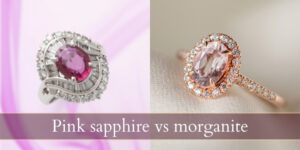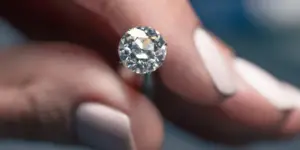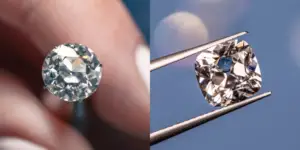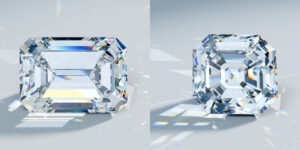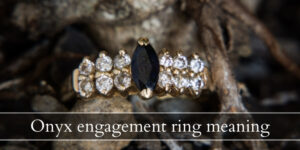Citrine and yellow topaz are the two leading yellow gems, and for good reason. They’re both luminous, beautiful to look at, and exude an aura of prosperity, generosity, and abundance. These are usually very clear gems – eye clean – so choosing between them is really difficult. If you find yourself debating whether you should get citrine or yellow topaz, debate no more ! Read on to find out their key differences, and which would be better suited for you.
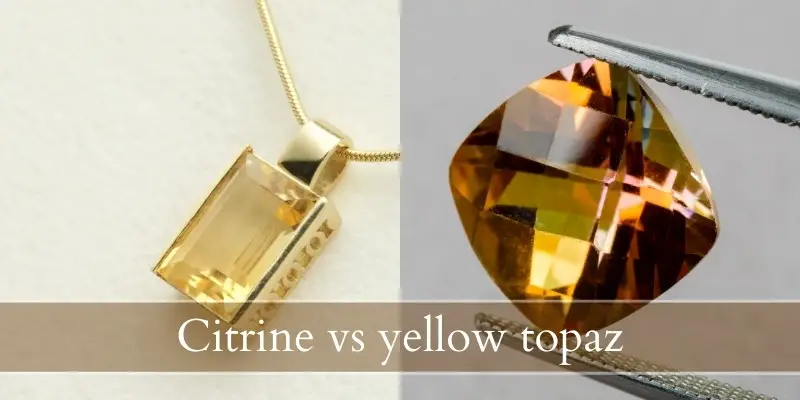
Citrine vs yellow topaz
Citrine is easier to find, and cheaper than yellow topaz, but citrine is a softer stone than yellow topaz which means it will scratch or chip faster. There is a slight difference in the color range, as citrine tends to be bright, sunny yellow with hints of amber while yellow topaz usually has an amber-to-orange hue, thus a more saturated color.
What is citrine ?
Citrine is a type of quartz, related to amethyst, rutilated quartz, and smoky quartz. Citrine owes its yellow color to iron hydroxide impurities, which give the gem a range from pale yellow to light brown. Most citrine on the market is in fact a pale amethyst that has been heat-treated to produce a yellow color.
What is yellow topaz ?
Yellow topaz is one of the most common natural colors of topaz. Topaz is commonly found as clear or pale yellow, but most often the yellow ones are heat-treated to obtain various shades of blue, including Swiss and London blue. Yellow topaz is often the result of a heat-treatment of a paler gemstone.
Both yellow topaz and citrine are November birthstones and are usually eye-clean, so both can be used as birthstones in personal jewelry. But let’s explore their differences so you can have a better picture of both gems.
Read also: What Is A Mother’s Ring ?
1. Yellow topaz is a harder gem than citrine
Topaz as a group is a harder gemstone than quartz (citrine in this case). This means that between the two gems, citrine will pick up more scratches and possibly even chip faster than yellow topaz. And if you were to hit them against each other you’d see that the yellow topaz will leave a mark on the citrine, but not the other way around.
Where a citrine scores a 7 out of 10 on the Mohs scale of hardness, yellow topaz scores an 8. Both can be worn every day, but yellow topaz will hold up better than citrine.
2. Citrine is cheaper than yellow topaz
If you’re looking at prices you’d definitely have an easier time with citrine, as it’s cheaper than yellow topaz. You can get citrine for about $20 per carat, possibly a bit more if the cut is perfect, the color is saturated, and the clarity is very good. Citrine can be eye-clean though you will easily find cloudy ones.
As for yellow topaz, it’s usually double the price of citrine. But, it will never be as much as imperial topaz, which tends to range from orange to salmon, sometimes showing red flashes. Those are over $1000 per carat, but yellow topaz lacks the reddish flashes to make it so expensive.
So do not worry, even if yellow topaz is more expensive than citrine you still won’t burn a hole in your pocket. Please keep in mind that these are just price ranges, and are expressed for loose gems, not gems already set in jewelry. Jewelry containing citrine or yellow topaz can vary wildly in price due to metals used, other gems involved, and total carat weight.
3. Yellow topaz is brighter, citrine is a deeper color
There is a color difference between citrine and yellow topaz to consider when choosing between them. Both gems have a range of color, but their ranges differ a little.
Citrine ranges from a pale yellow to brighter yellow and then takes a turn into light brown. It doesn’t usually get overly saturated and doesn’t have very warm undertones, at least compared to yellow topaz.
Yellow topaz starts from a warmer yellow and ranges to almost orange, with deep undertones that still don’t reach red.
Looking at each stone on their own doesn’t make it easy to compare the two, but if you set them side by side you will notice yellow topaz is usually deeper and a little warmer in color.
So if you’re looking for a very specific color, you now know which gem has a higher chance of offering it.
4. Citrine is easier to find than yellow topaz
As citrine is a type of quartz, it means it is a silica-based gem. These are the most common gem types, and are easily found everywhere on the planet. They are abundant and come in all sizes, to getting the right stone for a good price will not be difficult.
Yellow topaz is a bit rarer than quartz, but not as rare as other yellow gems (such as yellow sapphires). Still the market is flooded with blue topaz (Swiss, London, sky blue) and finding genuine yellow topaz is a pain. You will find either CZ dupes or blue topaz, so be very patient if you want yellow topaz and not citrine.
5. Yellow topaz is denser, thus heavier than citrine
When you’re buying large gems, or large quantities of gems the carat weight matters a whole lot. And this is where gem density starts to matter. A single carat won’t matter that much, but buying 20ct will make a difference.
You see, carats measure a stone’s weight, not its size in millimeters. So a 6 ct citrine will not look the same as a 6ct yellow topaz, because the yellow topaz will appear smaller. This is because yellow topaz is denser, so its atoms are packed tighter than citrine. It’s about 25% denser than citrine, which matter when you get a lot of stones, such as a big necklace or a tennis bracelet.
Yellow topaz has a density of 3.5 gr/cm3, while citrine has a density of 2.6 gr/cm3.
Both citrine and yellow quartz are November birthstones
You can use both citrine and yellow topaz in jewelry if you’re interested in having November birthstone jewelry. Why not take a look at the following jewelry pieces for some inspiration ?
Consider yellow sapphire as a non-birthstone alternative
If you’re looking for an alternative for these gems and don’t mind that it’s not a birthstone, then why not try yellow sapphire ? This gem brings a bright, warm yellow with a hardness that makes it resist scratches and chips and general wear and tear much better than citrine or yellow topaz.
Yellow sapphire has a Mohs rating of 9, so there’s not much you can do to it to hurt it. Of course, this gem is also very expensive, since it’s still a sapphire.

I’m the main author for jewelrymaterialguide.com. I started this site after we did tons of research before our wedding and noticed that there is information about rings, jewelry, and so on that is really hard to find on the internet.

